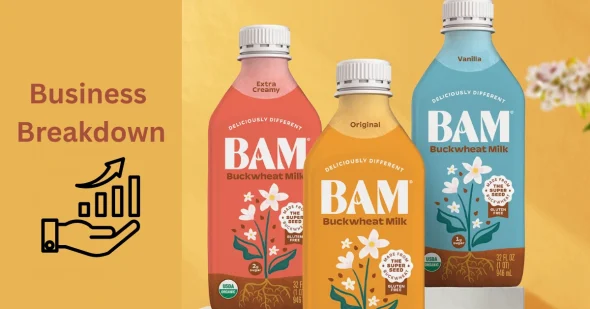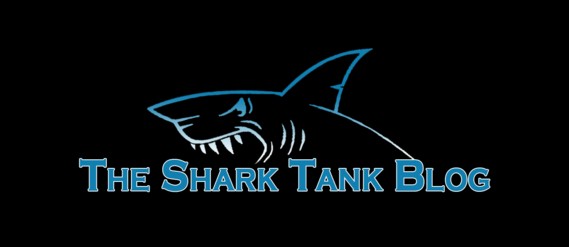
BAM is buckwheat milk with a mission. It is not like the other plant-based milk brands you might know. While other brands use common ingredients like almonds and oats, BAM does something different. They use buckwheat.
This crop is a healthy, gluten-free grain. It is not often found in plant milks. This gives BAM a distinctive taste. It also packs the drink with good elements like protein and fiber. It is less likely to cause allergies.
BAM Highlights
| Aspect | Details |
| Business Name | BAM – Because Agriculture Matters |
| Founding Year | 2023 |
| Founders | Paige Hansen |
| Product / USP | Buckwheat-based beverages (milk, smoothies, coffee). It focuses on sustainable farming and regenerative agriculture. |
| Shark Tank Episode | Season 16, Episode 14 |
| Deal Status | No deal |
| Revenue | $225K from an angel investor |
| Current Status | Active |
Beyond just the ingredients, BAM also cares a lot about how their food is grown. They work with farmers who focus on taking care of the soil and the environment. This means when you choose BAM, you’re not just getting a dairy alternative. You’re supporting a company that’s trying to do things the right way.
BAM – Founding Story
BAM started because of Paige Hansen. She grew up on a farm. Her family had been farming for five generations! So, she knows a lot about this field. She understands where our food comes from and how to keep that system well functioning.
She saw some problems with how farming works today and wanted to start a business that did things differently. Paige wanted to make something healthy and good for the planet. The aim was also to make sure farmers and nature were safe.
Paige picked buckwheat to make BAM’s milk. It is a really healthy grain. It grows well without a lot of water or chemicals. That makes it great for the environment.
With BAM, Paige wanted to change how people think about plant-based milk. She used buckwheat, which not many people use.
They have a bigger goal than just selling milk. They want to make a positive impact on farming and the planet. Now, that is something that matters to people who are thinking about more than just what they eat.
What’s on the BAM Menu?
BAM offers different buckwheat-based plant milks. Each of them is crafted to provide a unique taste. They all have nutritional profiles. Here’s what’s on the BAM menu:
- Original: This one offers a balanced and clean flavor. People buy it for its versatile nature. They use it for various purposes. Its smooth, neutral taste complements a wide range of recipes and beverages.
- Vanilla: This flavor is a little sweet. In texture, it is very creamy. People love to drink it by itself or put it in their coffee.
- Extra Creamy: If you want something even thicker, this is for you. It blends great in smoothies and lattes. Plus, it has extra protein to keep you feeling good.
BAM – Unique Features
BAM is an innovative product. It has several great features, such as:
- Made from Buckwheat – A rare, healthy ingredient that’s gluten-free and high in nutrients.
- Eco-Friendly – Buckwheat is good for the environment and helps improve soil health.
- Clean Ingredients – No unnecessary additives; the drinks are simple and natural.
- Farmer-Founded – Started by a real farmer who cares about better farming and food systems.
- More Than Just Milk – Offers smoothies and coffee drinks too, not just plant-based milk.
Who’s Drinking BAM? A Look at the Market
The target audience of BAM (Because Agriculture Matters) is:
- Health-conscious consumers – People who are looking for nutritious options. They also likely want gluten-free and dairy-free alternatives.
- Environmentally aware individuals – Those people who care about sustainability. They support regenerative farming.
- Vegans and vegetarians – Plant-based eaters looking for new non-dairy options.
- Allergy-sensitive consumers – People who have different kinds of allergies. They usually try to avoid common allergens like soy, dairy, or nuts.
- Young adults and millennials – These are particularly those in urban areas. Such people are trend-driven and open to trying innovative, clean-label food products.
- Ethical consumers – Buyers who support mission-driven brands and small-scale agriculture.
Scaling the BAM Vision
BAM, which stands for “Because Agriculture Matters,” has been growing slowly but surely since it started. They mostly sell their buckwheat milk directly to people online and by working with certain stores. Check out their official website for more details about it.
Being the first in America to make plant-based milk from buckwheat has helped them get noticed. More and more people are getting curious about their brand. We don’t know exactly how much money they’re making, but they’re starting to sell in more places. That means their business is getting bigger.
BAM Buckwheat Milk first showed up in stores in November 2023. They started small, in just 25 shops in San Diego. But people liked it! Now, in 2025, way more people are visiting their website, buying their milk, and talking about them online.
View this post on Instagram
Who Should Try BAM?
People who are looking for a better & healthier beverage can try it. These could be individuals who don’t have much time to prepare healthy food for themselves. People who want to avoid lactose and sugar can also try it out. So, customers like:
- People with dairy allergies or lactose intolerance.
- Individuals looking for a nut-free and soy-free plant-based milk.
- Consumers who follow a vegan or plant-based diet.
- Health-conscious buyers seeking clean-label beverages.
- People interested in sustainable and regenerative agriculture.
- Those who want to avoid added sugars and artificial ingredients.
- Parents looking for kid-friendly, nutritious dairy alternatives.
- Athletes or active individuals wanting a natural source of plant protein.
- Shoppers exploring unique superfoods like buckwheat.
- Anyone bored with standard almond, oat, or soy milk options.
The Pros and Cons of BAM
These are the key considerations that consumers look at while considering BAM plant-based milk:
| Pros | Cons |
| Unique buckwheat-based beverages – rare in the market | Taste may not appeal to everyone (noted by Sharks on the show) |
| Sustainable and eco-friendly – uses regenerative agriculture | Limited brand awareness compared to big plant-based brands |
| Clean, simple ingredients – no unnecessary additives | Niche product – buckwheat is not widely familiar to most consumers |
| Gluten-free, dairy-free, allergen-friendly | Premium pricing may not suit all budgets |
| Mission-driven and founded by a real farmer, it adds authenticity | No Shark Tank deal – may slow growth and scaling |
How BAM Generates Revenue
BAM makes money in two main ways: they sell their buckwheat milk straight to you online, and you can also find it in stores like Whole Foods. This helps them reach more people, whether you like to shop online or in person.
It costs BAM about $2.94 to make each bottle. They sell it for $4.95. That means they make a good amount of money on each one. When you buy it in a store, it costs between $8.29 and $10.99. That makes it a bit more expensive than some other plant-based milks.
This higher price is because it’s organic. It doesn’t have gluten and has a lot of protein. The stores that sell BAM also make a good profit. If BAM can make more milk at once, it will likely cost them less to produce each bottle. This could help them make even more money.
View this post on Instagram
Top Highlights from BAM Reviews
This overview is based on customer reviews from various BAM online platforms. Here’s a snapshot of what people are saying:
| What People Like (Positives) | What People Don’t Like (Negatives) |
| Eco-friendly and supports sustainable farming | Taste isn’t for everyone (some found it bland or unusual) |
| Unique buckwheat-based alternative to common plant milks | Limited flavor options compared to established brands |
| Clean ingredients with no artificial additives | Slightly expensive for a new, lesser-known product |
| Promotes a lesser-known but healthy grain – buckwheat | Availability may be limited in stores or certain regions |
| Authentic brand with a farmer-founder story | Buckwheat is unfamiliar to many, which may affect first impressions |
BAM’s Funding Journey
BAM’s story of getting money started with a big moment on the TV show Shark Tank. The person who started BAM, Paige Hansen, asked the “sharks” for $250,000 for a small piece of her company. She didn’t get a deal, but being on the show made a lot more people know about BAM. Their sales went up, more people visited their website, and they got more attention online.
Besides being on TV, BAM also got help from Whole Foods. They have a special program that helps small, new food companies, and BAM was part of it in 2023. This program gave Paige some advice and a $25,000 investment to help her business grow. It also helped BAM get the milk onto the shelves of Whole Foods stores, so more people could buy it.
Paige also worked with a group at Cornell University that helps food companies. They helped her make her product better and figure out how to keep it fresh longer. All of these ways of getting money and support have been really important in helping BAM grow from just a few stores in San Diego to a brand that people know in the plant-based milk world.
View this post on Instagram
BAM – Standing Out Among The Competitors
Its direct competitors are other brands that offer plant-based milk. Companies that sell wellness drinks are also competitors. Lastly, businesses that focus on sustainability and clean ingredients give good competition to BAM in the market. An analysis to study the market rivals:
| Feature | BAM | Oatly | Ripple | Elmhurst 1925 |
| Base Ingredient | Buckwheat | Oats | Pea protein | Almonds, oats, cashews, etc. |
| Unique Point | Regenerative farming, buckwheat | Creamy texture, mainstream appeal | High protein, low sugar | Clean label, few ingredients |
| Clean Ingredients | Yes | Often contains additives | Uses stabilizers | Yes (2–3 ingredients only) |
| Allergen-Friendly | Free from nuts, soy, and dairy | May contain gluten | No nuts, soy, or dairy | Contains nuts (varies by type) |
| Sustainability Focus | Strong (regenerative farming) | Moderate | Moderate | Strong (minimal waste process) |
| Taste | Earthy, nutty (not for everyone) | Creamy, neutral | Mildly sweet, protein-rich | Nutty, simple |
| Price Range | Mid to Premium | Moderate | Moderate | Premium |
| Availability | Limited (early-stage brand) | Widely available | Widely available | Niche stores and online |
Beyond Direct Competitors
Some more companies are indirect threats to BAM. These companies include:
- Silk: They make soy, almond, and oat milk, and you can find them almost everywhere. They’re also pretty affordable, so lots of folks choose them.
- Rebbl: This brand makes drinks that are meant to help you feel good, like give you energy or boost your immunity. If you’re into healthy stuff, you might like them because BAM also tries to be clean and good for you.
- MALK: They make drinks that are meant to help you feel good, like give you energy or boost your immunity. If you’re into healthy stuff, you might like them because BAM also tries to be clean and good for you.
BAM’s Marketing Moves
The company places itself as the first buckwheat plant-based milk in America. They talk a lot about how healthy it is. They try to show how it is good for the environment. Their marketing is around their nature-friendly personality. When they were on the TV show Shark Tank, a lot of people across the country saw them and heard about their eco-friendly goals.
To make their brand and packaging look and feel just right, BAM worked with a company called Designology. They even got customers involved in the process and tested different ideas to make sure people would like it. This helped BAM get noticed among all the other plant-based milks out there.
People, Partners & Processes
The person who started BAM, Paige Hansen, used what she knew from being a journalist. She also used her experience with farm technology to get BAM going. She also teamed up with the Cornell Food Venture Center to help take her idea from just a recipe in her kitchen to something they could sell in stores.
Being part of the Whole Foods program for new local businesses in 2023 was a big help. They gave Paige advice and support. That made it easier for BAM to start selling in some Whole Foods stores in Southern California.
Innovation and Expansion
BAM is doing something new with their milk. They use buckwheat. It’s good for you, doesn’t have gluten, and helps the soil. So, it’s healthy and good for the planet.
You can find BAM in stores like Whole Foods in California. They also ship their milk all over the country from their website. More and more people want to buy healthy things online, so this helps them reach more customers.
BAM uses simple ingredients and is really nutritious. They could become a leader in the special, more expensive plant-based milk section. They might even come up with new flavors and products, and maybe sell in other countries later on.
Proven Success with Awards, Appearances & Advocacy
BAM really cares about being sustainable and doing new things. Because of this, people in the food world have noticed them.
A magazine called Food Network Magazine put BAM on their “Green List” in 2024. They said it was one of the cool, eco-friendly things that impressed them.
Also, BAM was one of the finalists in a competition for natural products in San Diego. This shows that people in that community think BAM has a lot of potential and appeal.
What’s Next for BAM?
As more people like BAM’s special plant-based milk, they’re thinking about how to grow bigger. They’ll probably work on making more milk at a time to save money, so they can maybe sell it for a better price.
In the future, BAM might make new things, like buckwheat milk with different flavors or drinks you can grab and go. They also want to sell in more stores, not just in California.
Because lots of people care about being healthy and helping the planet, BAM could also start selling in other countries and team up with other healthy brands. Coming up with new ideas, being good to the environment, and growing smartly will be important for BAM’s future.
FAQs
1. Did BAM get a Shark Tank deal?
BAM could not secure any deal on Shark Tank as the Sharks felt that they were at a very early stage in the business to invest.
2. Who made BAM buckwheat milk?
The founder of BAM buckwheat is Paige Hansen. Her love for farming and her brilliant understanding of the skill led her to launch this company.
3. What are the ingredients in BAM milk?
They use an organic buckwheat base (water, organic buckwheat). Other ingredients that are used are organic coconut cream, regenerative organic cane sugar, organic acacia, and sea salt.





















This was beautiful Admin. Thank you for your reflections.
Great information shared.. really enjoyed reading this post thank you author for sharing this post .. appreciated
This is my first time pay a quick visit at here and i am really happy to read everthing at one place
What a lovely post.
This was beautiful Admin. Thank you for your reflections.
Awesome! Its genuinely remarkable post, I have got much clear idea regarding from this post